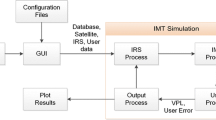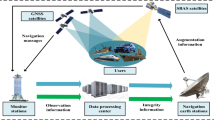Abstract
Following the recent development of wide-area differential technology, satellite-based augmentation systems (SBASs) have been applied in many fields. However, the capability of monitoring stations used for generating error correction might degenerate with the aging of ground equipment over time, and the poor geometry between ranging and integrity monitoring stations (RIMS) and satellites could affect the reliability of navigation systems in supplying safety of life service. Therefore, it is necessary to predict SBAS availability so that users can choose a safe and efficient navigation system. Predictions of user difference range error indicator (UDREI) and grid ionospheric vertical error indicator (GIVEI) are the two difficulties in predicting SBAS availability. Considering the effect of geometry on UDREI, satellite geometric dilution of precision is defined to distinguish different geometries such that the relationship between the number of visible RIMS and UDREI in different geometries can be obtained. With regard to the effect of geometry on GIVEI, a weighted number of visible ionospheric pierce points (IPPs) is defined to describe the geometric IPP distribution such that the relationship between the number of visible IPPs and GIVEI in different geometries can be achieved. Finally, experiments are performed to evaluate the effectiveness of our proposed method. With the prediction algorithm, the prediction is consistent with actual performance over 75.17% of the entire European region. In particular, when focusing on central Europe, where the distribution of RIMS is uniform, the level of consistency can reach 95–100%. It can be concluded that the prediction performance of the algorithm is encouraging and that this model may be considered a good contender for predicting SBAS availability.




















Similar content being viewed by others
References
Blanch J (2002) An ionosphere estimation algorithm for WAAS based on Kriging. In: Proceedings of ION GPS 2002, Institute of Navigation, Portland, OR, September 24–27, pp 816–823
FAA A (2010) AC 20-138B-airworthiness approval of positioning and navigation systems. http://www.faa.gov/documentLibrary/media/Advisory_Circular/AC%2020-138B.pdf
Fang JS, Zhu YB, Wang ZP (2013) Key parameters processing and analysis for EGNOS integrity. J Civ Aviat Univ China 31(1):13–17
Feng S, Ochieng WY, Walsh D, Ioannides R (2006) A highly accurate and computationally efficient method for predicting RAIM holes. J Navig 59(01):105–117
Gicquel JA, Arnaudy D, Gouni P (2016) EGNOS V3: engineering the future of GPS and Galileo augmentation over Europe. Complex systems design and management. Springer, Berlin, p 289
Hauschild A, Montenbruck O (2016) A study on the dependency of GNSS pseudorange biases on correlator spacing. GPS Solut 20(2):159–171
Hawkins DM (2004) The problem of overfitting. J Chem Inf Comput Sci 44(1):1–12
Jan SS, Chan W, Walter T, Enge P (2001) Matlab simulation toolset for SBAS availability analysis. In: Proceedings of ION GPS 2001, Institute of Navigation, Salt Lake City, UT, September 2001, pp 2366–2375
Juan B, Todd W, Per E (2002) Ionospheric threat model methodology for WAAS. Navigation 49(2):103–107
Li X, Zhu Y, Xue R (2011) Ionospheric delay correction and integrity monitoring based on Kriging in GRIMS. Energy Proc 13:659–667
Luo Y, Babu R, Wu WQ, He XF (2012) Double-filter model with modified Kalman filter for baseband signal pre-processing with application to ultra-tight GPS/INS integration. GPS Solut 16(4):463–476
Mannucci AJ, Wilson BD, Edwards CD (1993) A new method for monitoring the earth’s ionospheric total electron content using the GPS global network. In: Proceedings of ION GPS 1993, Institute of Navigation, Salt Lake City, UT, September 1993, pp 1323–1332
Pandya N, Wu JS, Grewal M (2000) Dependence of GEO UDRE on ground station geometries. In: Proceedings of ION NTM 2000, Institute of Navigation, Anaheim, CA, January 2000, pp 80–90
Prasad N, Sarma AD (2004) Ionospheric time delay estimation using IDW grid model for GAGAN. J Indian Geophys Union 8(4):319–327
Rovira-Garcia A, Juan JM, Sanz J, González-Casado G, Ibáñez D (2015) Accuracy of ionospheric models used in GNSS and SBAS: methodology and analysis. J Geodesy 90(3):229–240
RTCA DO229D (2006) Minimum operational performance standards for global positioning system or wide area augmentation system airborne equipment, Tech Rep DO229D, RTCA
Sardon E, La Fuente JAD, Zarraoa N, Nieto J, Cosmen J (1998) Udre computation: a key issue for space based augmentation system performance. In: Proceedings of ION GPS 1998, Institute of Navigation, Nashville, TN, September 15–18, pp 2091–2100
Shively CA, Braff R (2000) An overbound concept for pseudorange error from the LAAS ground facility. In: Proceedings of ION AM 2000, Institute of Navigation, San Diego, CA, June 26–28, pp 661–671
Telegraph (2013) Five drivers follow satnav down the stairs in Spanish town. http://www.telegraph.co.uk/news/worldnews/europe/spain/10094276/Five-drivers-follow-satnav-down-the-stairs-in-Spanish-town.html
Trilles S, Authié T, Renazé C, Raoul O (2015) Robust EGNOS availability performances under severe ionospheric conditions. In: Proceedings of ION GNSS + 2015, Institute of Navigation, Tampa, Florida, September 14–18, pp 1783–1789
Wang ZP, Macabiau C, Zhang J, Escher AC (2014) Prediction and analysis of GBAS integrity monitoring availability at LinZhi airport. GPS Solut 18(1):27–40
Yun Y (2015) Influence of reference station distribution on the Korean SBAS performance. In: Proceedings of ION PNT 2015, Institute of Navigation, Hawaii, April 20–23, pp 964–969
Zhu Y, Zhang M, Zhang J (2009) Research on weighted algorithm to predict RAIM availability. J Telem Track Command 01:1–6
Acknowledgements
The authors would like to give thanks to many people for their advice and interest. Christophe Macabiau from École Nationale de l’Aviation Civile provided rounded guidance on the technical details of the paper. Norbert Suard from Centre National d’Etudes Spatiales patiently provided all the positional information regarding the ranging and integrity monitoring stations of Geostationary Navigation Overlay Service (EGNOS). Ridha Chaggara from European Satellite Services Provider offered the actual EGNOS availability. Without the kind assistance of these people, this work could not have been conducted. This work was undertaken with financial support from the National Natural Science Foundation of China (Grant No. 61501010), Beijing Municipal Natural Science Foundation (Grant No. 4154078), and Aeronautics Science Foundation (Grant No. 2015ZC51035).
Author information
Authors and Affiliations
Corresponding author
Rights and permissions
About this article
Cite this article
Zhi, W., Wang, Z., Zhu, Y. et al. Availability prediction method for EGNOS. GPS Solut 21, 985–997 (2017). https://doi.org/10.1007/s10291-016-0582-5
Received:
Accepted:
Published:
Issue Date:
DOI: https://doi.org/10.1007/s10291-016-0582-5




